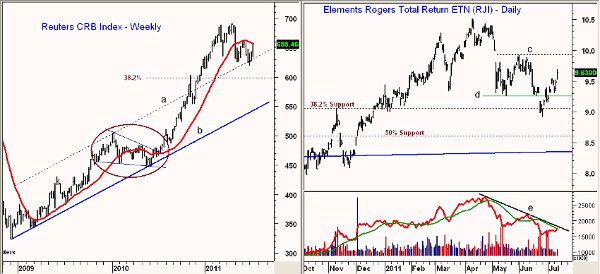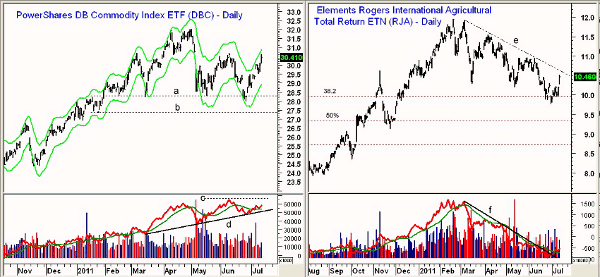Technical indicators suggest that the commodities correction may be over, and now is a good time to establish long positions in select broad-based or more specialized commodity ETFs.
Silver’s sharp reversal in May caused selling in many of the commodity markets, so it was not surprising that Barclay’s Capital estimated that $6.5 billion came out of the commodity markets in May. Further outflows in June means the rate of outflows is almost as much as what moved out of the commodity funds in late 2008.
Of course, this was at the height of the financial crisis. The open interest in many of the individual commodities has also dropped sharply, as fewer are willing to hold long positions. For example, the open interest in coffee and copper were both down over 70%.
On May 5, I suggested that “The Commodity Bull Market Isn’t Over.” At the time, my analysis suggested that “A deeper correction and a significant retracement of the recent gains should be an opportunity to establish either 1) long positions in a broad-based commodity vehicle, or 2) targeted positions in a specific commodity market.”
The commodity markets have firmed over the past two weeks, suggesting that the correction may be over. The added pressure on the US dollar over the widening concern over the debt ceiling is also a positive for the commodity markets, and so too are China’s recent growth numbers.
Chart Analysis: The Reuters CRB Index declined to just below the upper boundary of its weekly trading channel (line a) and the 620 level was briefly broken. The 38.2% support from last summer's low is at 600 with the 50% level just under 570.
- The current correction has not lasted quite as long as the one that occurred in early 2010 (see circle), but this one is taking a similar shape
- There is key weekly resistance at 662.37, and a close above this level will indicate that the correction in commodities is over
- Once above the previous high at 691, the next upside target is in the 712 area
Elements Rogers Total Return ETN (RJI) was designed to track the global consumption of a basket of 36 commodities. It has 35% in agricultural commodities, 21% in both precious and base metals, and the remaining 44% in energy.
- RJI peaked on April 8 at $10.51 and dropped to a low of $8.91 on June 24
- This drop slightly violated the 38.2% support at $9.05 with the 50% support at $8.60
- Short-term support is now in the $9.25-$9.42 area
- The daily on-balance volume (OBV) is now testing its declining weighted moving average (WMA) and the downtrend, line e. The weekly OBV (not shown) confirmed the April highs and has held above its rising weighted moving average on the correction
- Next resistance is at $9.90 and a close above this level should complete the correction
Coming Soon: Read today’s Trading Lesson to learn more about OBV analysis
NEXT: More Commodity ETFs to Play an Impending Rally
|pagebreak|PowerShares DB Commodity Index ETF (DBC) is more narrowly focused than RJI, as it includes the commodities like light sweet crude oil (West Texas Intermediate, or WTI), heating oil, RBOB* gasoline, natural gas, Brent crude, gold, silver, aluminum, zinc, copper grade A, corn, wheat, soybeans, and sugar.
*RBOB: Reformulated Blendstock for Oxygenate Blending. This is the benchmark gasoline product traded on the major commodity exchanges.
- After peaking at $32.20, DBC dropped below first support (line a) at $28.27 before turning around. It came very close to the daily Starc-band, but held above the stronger support at $27.40, line b
- The daily OBV held its uptrend, line d, on the recent correction and has moved back above its weighted moving average. It is acting stronger than prices and is very close to its prior highs, line c
- Weekly OBV has held above its weighted moving average on the correction and could make new highs this week
- The rally has taken DBC close to the latest high at $30.68 with the daily Starc+ band at $30.89
- There is further resistance at $31.34 and then at $32.02. The 127.2% retracement resistance target is at $33.10
- Short-term support is now in the $29.80-$30.20 area and then at $29.40
The Elements Rogers International Agricultural Total Return ETN (RJA) closed below the 38.2% support for two days in the latter part of June, hitting a low of $9.76 before rebounding sharply.
- The daily downtrend (line e) is at $10.64 with further resistance in the $10.90-$11.10 area. Once above the early-2011 highs at $11.95, the 127.2% Fibonacci target is at $12.55.
- The daily OBV has broken its steep downtrend, line f, as volume has increased on the rally. The weekly OBV (not shown) did confirm the recent highs but is well below its now- flat weighted moving average
- There is short-term support now at $10.50 with further support in the $10-$10.20 area
What It Means: Though the agricultural sector is still lagging, the action in the broader commodity markets suggests the correction from the recent highs is likely over. One more pullback to the highs of a few weeks ago is possible, but I would not be surprised to see RJA and DBC at new highs by the end of the summer.
How to Profit: As recommended in May, buyers of the Elements Rogers Total Return ETN (RJI) should be 50% long at $9.24 and 50% long at $9.08 with a stop at $8.57. On a close above $10.05, raise the stop to $8.77.
The PowerShares DB Commodity Index ETF (DBC) missed my initial buying zone by just eight cents. I would now go 50% long at $30.06 and 50% long at $29.77 with a stop at $28.66 (risk of approx. 4.3%).
For the Elements Rogers International Agricultural Total Return ETN (RJA), buyers should be long 50% long at $9.96, although the second buying zone at $9.54 was missed. Use a stop now at $8.94.
In the May article, I recommended going 50% long the United States Oil Fund (USO) at $38.66 and 50% long at $37.94. Both positions were stopped out at $36.89, resulting in an approximate 3.9% loss.
I also recommended a 50% long position in United States Natural Gas Fund (UNG) at $10.77 and a 50% long position at $10.44. Keep the stop at $9.89, as UNG closed Wednesday at $11.02.












